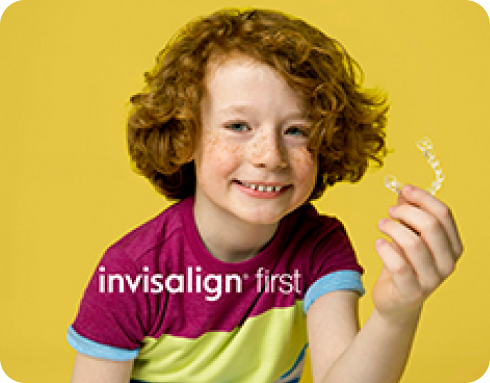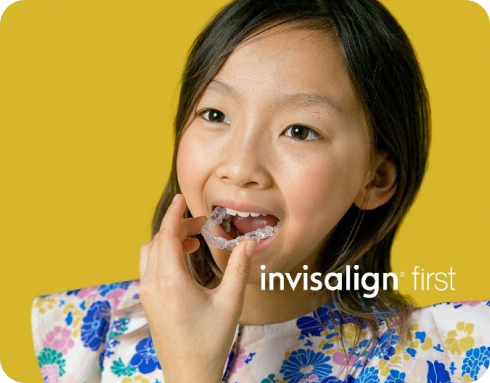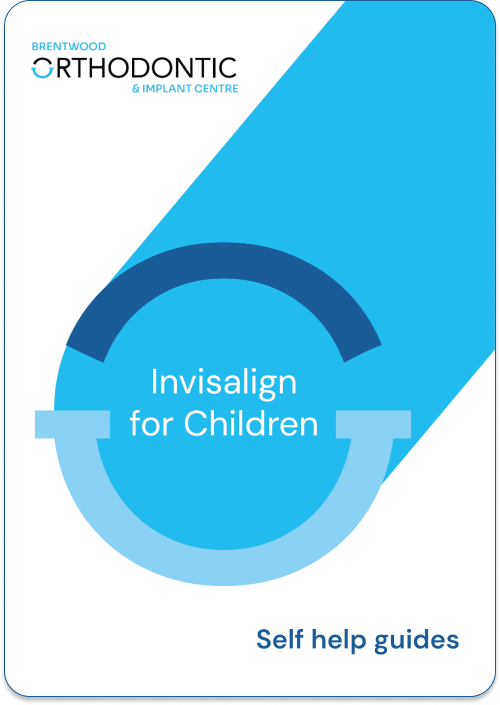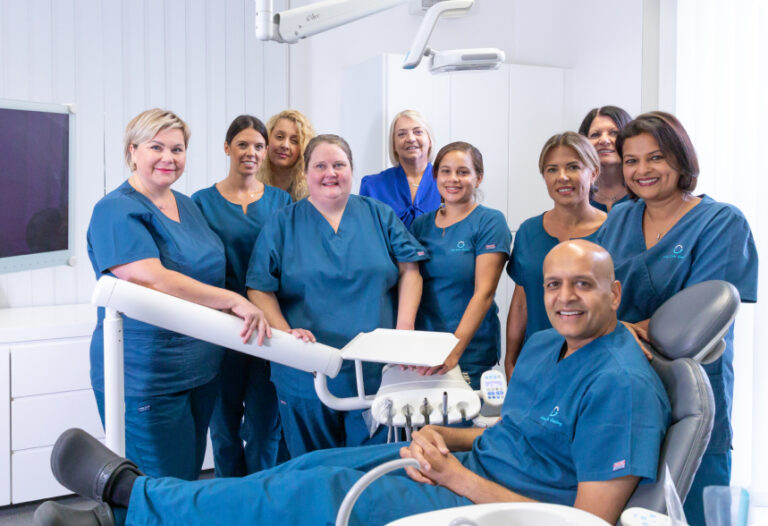Live Life Smiling
Specific device designed for younger children
Invisalign First is an orthodontic treatment device designed specifically for young children aged 6-12. As well as correcting issues with arch development and expansion it is also used to improve tooth crowding and spacing, tooth protrusions – all contributing to the overall appearance of a child’s smile.
What can I expect from Invisalign First?
The custom Invisalign First trays are designed to gradually expand the jawline of a growing child. They work by expanding the arch area, meaning that over time we can correct current issues – as well as help prevent more serious problems in the future.
Invisalign Teen is designed specifically for teenagers, using transparent custom-moulded aligners to gently move teeth. Discover more about this treatment in our Patient Guide here.
Invisalign First is used for making various corrections in the positioning of growing jaw with unique features for dental arch expansion and creating room for incoming teeth. Invisalign First can be used to address various orthodontic conditions, such as;
- arch development,
- expansion,
- spacing/crowding,
- A-P correction,
- aesthetic alignment,
- tooth protrusions or interferences
Invisalign First is only available for growing children.
How does Invisalign First work?
Invisalign First works by expanding and contouring your child’s jawline through what is known as dental arch expansion. Dental arch expansion involves pushing your child’s teeth over time to increase the width of their dental arch.
The procedure for dental arch expansion starts with a consultation to determine if your child is an appropriate candidate for Invisalign First. If approved, your child’s orthodontist can begin taking pictures, x-rays, and impressions of your child’s smile that same day. Information from the imaging, x-rays, and impressions will go to an Invisalign lab where a custom Invisalign First device, called an aligner or tray, will be made for your child.
It will take a few weeks until the custom aligner is ready. Once the aligner is ready, your child will be scheduled to come back to fit the aligner to your child’s smile. Over time the device will shift your child’s teeth around as required.
Depending on your child’s needs, he or she may require a full pair of aligners or just one jaw. Certain teeth may require attachments to be placed on their surface.



What are the benefits of Invisalign First?
The benefits include;
- allowing younger children to receive a similar Invisalign experience to adults and teens,
- customised planning around your child’s unique dental needs,
- treatment for a broad range of orthodontic malformations,
- providing room for incoming teeth without removing surrounding teeth,
- supporting teeth and jawline formation with preferred aesthetics vs. traditional braces,
- your child can remove the device to maintain comfort while eating, drinking, brushing their teeth, or other activities.
Why Invisalign for Children?
Because children (and their mouths) are constantly on the move, there are a few special features:
- Blue Wear Indicators
Blue wear-indicators at the rear of the aligners that fade from blue to clear will help the doctor and parents identify if the patient has been wearing their aligners for the enough length of time.
- Eruption Compensators
In order to compensate for the eruption of canines, second premolars and second molars, special features have been created.
Invisalign Mandibular Advancement
For older children, mandibular advancement from Invisalign is available to growing patients who are in the late baby dentition to permanent dentition, 10-15 years of age.
Can you tell me more about Invisalign treatment with Mandibular advancement?
Invisalign doesn’t use traditional brackets and wires. Instead, it uses precision wings, located on the top and bottom aligners. These wings interlock to hold the jaw in a forward position. This offers the first clear aligner solution for Class II correction, resulting in moving (posturing) the lower jaw forward while simultaneously aligning the teeth. This constant posturing will have some alveolar bone remodelling that will allow for some correction. This may mean shorter treatment times for patients because previously, orthodontists would correct the jaw position first, then move the teeth at a later phase of treatment. If both can be accomplished at the same time, patients are able to realise shorter treatment times. The great thing about this is that this offers a very patient-friendly way to achieve great results in about half the time.
What are Class II Treatments?
In Class II treatments, doctors are aligning the teeth and advancing the lower jaw to improve the patient’s profile. Invisalign Teen with mandibular advancement is designed to replicate the action of commonly used functional appliances for Class II correction through new upper and lower ‘precision wings’ which hold the mandible in a forward position, while simultaneously correcting malocclusion and crowding issues. Traditionally, doctors usually correct the mandible position and straighten the teeth in separate phases, resulting in a longer overall treatment time.

